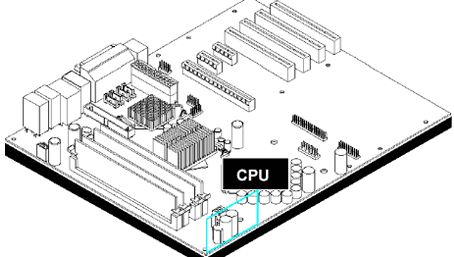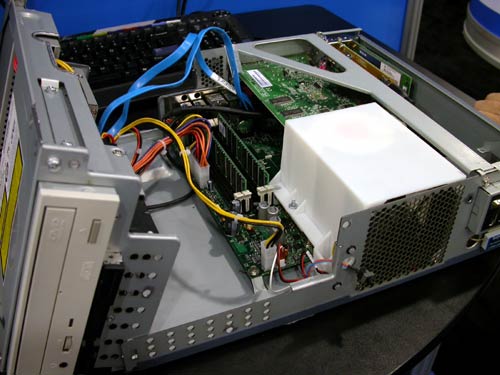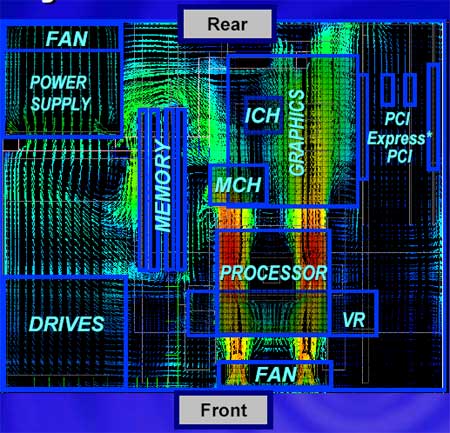Balanced Technology eXtended (BTX) Form Factor - The Future of Cases & Motherboards
by Anand Lal Shimpi on September 18, 2003 12:34 PM EST- Posted in
- Cases/Cooling/PSUs
BTX - The Basics
Just in case you were told otherwise, the BTX form factor is largely incompatible with the ATX form factor - the only area where this doesn't fully apply is in power supply support, as you can use ATX power supplies with BTX motherboards (more on this later).
In order to understand BTX you have to understand the motives for change. CPUs are getting hotter, graphics cards are as well, and despite all of these increases in thermal dissipation there is an increase in demand for quieter PCs. Today's ATX cases and motherboards were not designed for the incredible levels of heat that they have to deal with, and it is with this that we begin our understanding of BTX.
Pictured below you will see a BTX motherboard reference design:

The first thing that you'll notice about the BTX form factor is that the expansion slots have switched sides. In the picture above you'll see a total of 7 slots, from left to right we have a PCI Express x16 slot, two PCI Express x1 slots and four 32-bit PCI slots. Note that the slot closest to the CPU is the PCI Express x16 slot, which will be used for graphics, allowing it to share some of the CPU's cooling.
The redesign of the board layout was done in order to improve airflow through the system; moving the CPU to the "front" of the case allows it to be right next to the intake fan, giving it the coolest air out of any component in the system. You will then notice that the chipset is directly in line with the CPU, allowing airflow over the CPU's heatsink to be channeled over those heatsinks as well before exiting the case. This direct line of airflow allows for very efficient cooling of not only the CPU, but the voltage regulators, chipset and graphics card.
The memory slots have been moved to the left edge of the motherboard, but are also able to receive cooling courtesy of the thermal module, as it is known, that is mounted over the CPU. You can see a good example of what the thermal module will look like below:

The white plastic duct encloses what is known as the "thermal module," which at this point is basically a heatsink and a fan. In the future, the thermal module could encapsulate some more exotic cooling forms such as heatpipes or potentially even water cooling. In this particular design, the fan seen above is a 90mm unit.
In order to understand the cooling flow within a BTX system, take a look at the picture below:

In the depiction above the graphics card is mounted on a riser card, although it can also be mounted vertically.










99 Comments
View All Comments
Anonymous User - Friday, September 19, 2003 - link
This is a lame arse attempt from Intel in an effort to get everyone to upgrade entire systems.Upgrading means :
(1) profits (PCI-X, new mobos, new CPUs, new bloody everything!)
(2) they can stick in that Secured Computing crap (La Grande) => control what can be played or viewed. Which means RIAA don't have to sue anymore. It also means goodbye P2P, MP3, Region Free DVD, and all the joys of PC. Prepare to be butt-f*ck by MS in all positions.
Remember people this is technology consumers can easily reject.
Simply put, if you don't like it...Don't buy it, don't accept it. There's no one pointing a gun to your head. Intel will see BTX is a failure if no one adopts it.
Anonymous User - Friday, September 19, 2003 - link
Well, hopefully AMD will see the light and not jump on the BTX bandwagon. Gone are the days where Intel had no strong competitors. If AMD simply requests their motherboard manufacturers to stick with the ATX format or modified ATX format with several of the changes suggested in this forum, the BTX format will likely die a quick death. I'm not an AMD fanboy (I have 3 Intel computers) but AMD can force such a BTX resistance in the motherboard industry, I'd support them.Anonymous User - Friday, September 19, 2003 - link
My opinions:- Put the CPU in a separate cooling loop. Otherwise your graphics card is going to be suffering trying to cool itself with air at 35°C
- As other people have mentioned: standardise the motherboard plugs for reset/power/speaker.
- Make a standard tiny BTX (femtoBTX?) version, possibly stacked boards with SODIMMs and everything onboard.
Anonymous User - Friday, September 19, 2003 - link
What about cards that pop out during shipping. PCI was bad for this, and AGP was worse. I'm scared that PCI-X, especially 1X will be horrible for this. And #53, the ACR was a gateway to the built-in AC'97 codec, especially for modems, if I'm not mistaken.Anonymous User - Friday, September 19, 2003 - link
Everyone here seems to have forgotten about the old "Advanced Communications Riser" or ACR, which was supposed to be a cheap solution for putting on modems, audio cards, etc. I believe this PCI Express x 1 is the revival of this horrible standard.Anonymous User - Friday, September 19, 2003 - link
Hmm, isn't that where the CPU was in the first place (on the old AT boards) before ATX moved it?Anonymous User - Friday, September 19, 2003 - link
What about the new Apple G5 cooling system? Do something like that for PCs with "thermal zones" to dissipate heat and very very quiet:http://www.apple.com/powermac/design.html
Anonymous User - Friday, September 19, 2003 - link
Innovation? My Ar$e!This is just a step back to the bad old days of low profile cases & riser cards. Find a pic of an old vtec 486sx and aside form the lack of cooling system *cough* plastic box its the same!
Swicthing everything to the other side of the mobo is a stinky ploy to get us to buy new new cases.
How about dual cpu systems, where will the second cpu go, and will it get its own cooling system (lol), or will we get 2BTX cheep at twice the price.
That and there is no way in hell my 1/2" water cooling setup will fit :|
Anonymous User - Friday, September 19, 2003 - link
It all depends on whether a PCIX1 or PCIX16 card will work in a PCIX32 slot. If they do, just MBs with all PCIX32 slots.jema - Friday, September 19, 2003 - link
What I dont like is that they are still going for the 'agp scenario' with one PCI express x16 port one the rest x1. Why not make all the card connectors the same size and speed so you can use what ever card you want in any slot? Not everyone will need the gfx card to have the most bandwith in the machine.